*NURSING > NCLEX-RN > C H A P T E R 8_ Fluids and Electrolytes: From Saunders Comprehensive Review for the NCLEX-RN Examin (All)
C H A P T E R 8_ Fluids and Electrolytes: From Saunders Comprehensive Review for the NCLEX-RN Examination 8th Edition. (Available: https://bit.ly/2HeJuMt ). Contains Practice questions and Answers with the Rationale, Test-Taking Strategy, Level of Cognitive Ability, Client Needs, Integrated Process, Content Area, Health Problem, Priority Concepts and Reference
Document Content and Description Below
Priority Concepts Cellular Regulation; Fluid and Electrolytes I. Concepts of Fluid and Electrolyte Balance A. Electrolytes 1. Description: An electrolyte is a substance that, on dissolving in sol... ution, ionizes; that is, some of its molecules split or dissociate into electrically charged atoms or ions (Box 8-1). 2. Measurement a. The metric system is used to measure volumes of fluids—liters (L) or milliliters (mL). b. The unit of measure that expresses the combining activity of an electrolyte is the milliequivalent (mEq). c. One milliequivalent (1 mEq) of any cation always reacts chemically with 1 mEq of an anion. d. Milliequivalents provide information about the number of anions or cations available to combine with other anions or cations. B. Body fluid compartments (Fig. 8-1) 1. Description a. Fluid in each of the body compartments contains electrolytes. b. Each compartment has a particular composition of electrolytes, which differs from that of other compartments. c. To function normally, body cells must have fluids and electrolytes in the right compartments and in the right amounts. 233d. Whenever an electrolyte moves out of a cell, another electrolyte moves in to take its place. e. The numbers of cations and anions must be the same for homeostasis to exist. f. Compartments are separated by semipermeable membranes. 2. Intravascular compartment: Refers to fluid inside a blood vessel 3. Intracellular compartment a. The intracellular compartment refers to all fluid inside the cells. b. Most bodily fluids are inside the cells. 4. Extracellular compartment a. Refers to fluid outside the cells. b. The extracellular compartment includes the interstitial fluid, which is fluid between cells (sometimes called the third space), blood, lymph, bone, connective tissue, water, and transcellular fluid. C. Third-spacing 1. Third-spacing is the accumulation and sequestration of trapped extracellular fluid in an actual or potential body space as a result of disease or injury. 2. The trapped fluid represents a volume loss and is unavailable for normal physiological processes. 3. Fluid may be trapped in body spaces such as the pericardial, pleural, peritoneal, or joint cavities; the bowel; the abdomen; or within soft tissues after trauma or burns. 4. Assessing the intravascular fluid loss caused by thirdspacing is difficult. The loss may not be reflected in weight changes or intake and output records and may not become apparent until after organ malfunction occurs. D. Edema 1. Edema is an excess accumulation of fluid in the interstitial space; it occurs as a result of alterations in oncotic pressure, hydrostatic pressure, capillary permeability, and lymphatic obstruction (see F. Body fluid transport, for descriptions). 2. Localized edema occurs as a result of traumatic injury from accidents or surgery, local inflammatory 234processes, or burns. 3. Generalized edema, also called anasarca, is an excessive accumulation of fluid in the interstitial space throughout the body and occurs as a result of conditions such as cardiac, renal, or liver failure. E. Body fluid 1. Description a. Body fluids transport nutrients to the cells and carry waste products from the cells. b. Total body fluid (intracellular and extracellular) amounts to about 60% of body weight in the adult, 55% in the older adult, and 80% in the infant. c. Thus infants and older adults are at a higher risk for fluid-related problems than younger adults; children have a greater proportion of body water than adults, and the older adult has the least proportion of body water. 2. Constituents of body fluids a. Body fluids consist of water and dissolved substances. b. The largest single fluid constituent of the body is water. c. Some substances, such as glucose, urea, and creatinine, do not dissociate in solution; that is, they do not separate from their complex forms into simpler substances when they are in solution. d. Other substances do dissociate; for example, when sodium chloride is in a solution, it dissociates, or separates, into 2 parts or elements. Infants and older adults need to be monitored closely for fluid imbalances. F. Body fluid transport 1. Diffusion a. Diffusion is the process whereby a solute (substance that is dissolved) may spread through a solution or solvent (solution in which the solute is dissolved). 235b. Diffusion of a solute spreads the molecules from an area of higher concentration to an area of lower concentration. c. A permeable membrane allows substances to pass through it without restriction. d. A selectively permeable membrane allows some solutes to pass through without restriction but prevents other solutes from passing freely. e. Diffusion occurs within fluid compartments and from one compartment to another if the barrier between the compartments is permeable to the diffusing substances. 2. Osmosis a. Osmosis is the movement of solvent molecules across a membrane in response to a concentration gradient, usually from a solution of lower to one of higher solute concentration. b. Osmotic pressure is the force that draws the solvent from a less concentrated solute through a selectively permeable membrane into a more concentrated solute, thus tending to equalize the concentration of the solvent. c. If a membrane is permeable to water but not to all solutes present, the membrane is a selective or semipermeable membrane. d. When a more concentrated solution is on one side of a selectively permeable membrane and a less concentrated solution is on the other side, a pull called osmotic pressure draws the water through the membrane to the more concentrated side, or the side with more solute. 3. Filtration a. Filtration is the movement of solutes and solvents by hydrostatic pressure. b. The movement is from an area of higher pressure to an area of lower pressure. 4. Hydrostatic pressure 236a. Hydrostatic pressure is the force exerted by the weight of a solution. b. When a difference exists in the hydrostatic pressure on two sides of a membrane, water and diffusible solutes move out of the solution that has the higher hydrostatic pressure by the process of filtration. c. At the arterial end of the capillary, the hydrostatic pressure is higher than the osmotic pressure; therefore, fluids and diffusible solutes move out of the capillary. d. At the venous end, the osmotic pressure, or pull, is higher than the hydrostatic pressure, and fluids and some solutes move into the capillary. e. The excess fluid and solutes remaining in the interstitial spaces are returned to the intravascular compartment by the lymph channels. 5. Osmolality a. Osmolality refers to the number of osmotically active particles per kilogram of water; it is the concentration of a solution. b. In the body, osmotic pressure is measured in milliosmoles (mOsm). c. The normal osmolality of plasma is 275 to 295 mOsm/kg (275 to 295 mmol/kg). G. Movement of body fluid 1. Description a. Cell membranes and capillary walls separate body compartments. b. Cell membranes are selectively permeable; that is, the cell membrane and the capillary wall allow water and some solutes free passage through them. c. Several forces affect the movement of water and solutes through the walls of cells and capillaries; for example, the greater the number of particles within the cell, the more pressure exists to force the water through the cell membrane out of the cell. d. If the body loses more electrolytes than fluids, as can happen in diarrhea, then 237the extracellular fluid contains fewer electrolytes or less solute than the intracellular fluid. e. Fluids and electrolytes must be kept in balance for health; when they remain out of balance, death can occur. 2. Isotonic solutions a. When the solutions on both sides of a selectively permeable membrane have established equilibrium or are equal in concentration, they are isotonic. b. Isotonic solutions are isotonic to human cells, and thus very little osmosis occurs; isotonic solutions have the same osmolality as body fluids. c. Refer to Chapter 69, Table 69-1, for a list of solutions, types, and uses. 3. Hypotonic solutions a. When a solution contains a lower concentration of salt or solute than another, more concentrated solution, it is considered hypotonic. b. A hypotonic solution has less salt or more water than an isotonic solution; these solutions have lower osmolality than body fluids. c. Hypotonic solutions are hypotonic to the cells; therefore, osmosis would continue in an attempt to bring about balance or equality. d. Refer to Chapter 69, Table 69-1, for a list of solutions, types, and uses. 4. Hypertonic solutions a. A solution that has a higher concentration of solutes than another, less concentrated solution is hypertonic; these solutions have a higher osmolality than body fluids. b. Refer to Chapter 69, Table 69-1, for a list of solutions, types, and uses. 5. Osmotic pressure a. The amount of osmotic pressure is determined by the concentration of solutes in solution. b. When the solutions on each side of a selectively permeable membrane are equal in concentration, they are isotonic. 238c. A hypotonic solution has less solute than an isotonic solution, whereas a hypertonic solution contains more solute. 6. Active transport a. If an ion is to move through a membrane from an area of lower concentration to an area of higher concentration, an active transport system is necessary. b. An active transport system moves molecules or ions against concentration and osmotic pressure. c. Metabolic processes in the cell supply the energy for active transport. d. Substances that are transported actively through the cell membrane include ions of sodium, potassium, calcium, iron, and hydrogen; some of the sugars; and the amino acids. H. Body fluid intake and output (Fig. 8-2) 1. Body fluid intake a. Water enters the body through 3 sources—orally ingested liquids, water in foods, and water formed by oxidation of foods. b. About 10 mL of water is released by the metabolism of each 100 calories of fat, carbohydrates, or proteins. 2. Body fluid output a. Water lost through the skin is called insensible loss (the individual is unaware of losing that water). b. The amount of water lost by perspiration varies according to the temperature of the environment and of the body. c. Water lost from the lungs is called insensible loss and is lost through expired air that is saturated with water vapor. d. The amount of water lost from the lungs varies with the rate and the depth of respiration. e. Large quantities of water are secreted into the gastrointestinal tract, but almost all of this fluid is reabsorbed Practice Questions 39. The nurse is caring for a client with heart failure. On assessment, the nurse notes that the client is dyspneic, and crackles are audible on auscultation. What additional manifestations would the nurse expect to note in this client if excess fluid volume is present? 1. Weight loss and dry skin 2. Flat neck and hand veins and decreased urinary output 3. An increase in blood pressure and increased respirations 4. Weakness and decreased central venous pressure (CVP) 40. The nurse reviews a client’s record and determines that the client is at risk for developing a potassium deficit if which situation is documented? 1. Sustained tissue damage 2. Requires nasogastric suction 3. Has a history of Addison’s disease 4. Uric acid level of 9.4 mg/dL (557 mcmol/L) 41. The nurse reviews a client’s electrolyte laboratory report and notes that the potassium level is 2.5 mEq/L (2.5 mmol/L). Which patterns should the nurse watch for on the electrocardiogram (ECG) as a result of the laboratory value? Select all that apply. 1. U waves 2. Absent P waves 3. Inverted T waves 4. Depressed ST segment 5. Widened QRS complex 42. Potassium chloride intravenously is prescribed for a client with heart failure experiencing hypokalemia. Which actions should the nurse take to plan for preparation and administration of the potassium? Select all that apply. 1. Obtain an intravenous (IV) infusion pump. 2632. Monitor urine output during administration. 3. Prepare the medication for bolus administration. 4. Monitor the IV site for signs of infiltration or phlebitis. 5. Ensure that the medication is diluted in the appropriate volume of fluid. 6. Ensure that the bag is labeled so that it reads the volume of potassium in the solution. 43. The nurse is assessing a client with a lactose intolerance disorder for a suspected diagnosis of hypocalcemia. Which clinical manifestation would the nurse expect to note in the client? 1. Twitching 2. Hypoactive bowel sounds 3. Negative Trousseau’s sign 4. Hypoactive deep tendon reflexes 44. The nurse is caring for a client with Crohn’s disease who has a calcium level of 8 mg/dL (2 mmol/L). Which patterns would the nurse watch for on the electrocardiogram? Select all that apply. 1. U waves 2. Widened T wave 3. Prominent U wave 4. Prolonged QT interval 5. Prolonged ST segment 45. The nurse reviews the electrolyte results of a client with chronic kidney disease and notes that the potassium level is 5.7 mEq/L (5.7 mmol/L). Which patterns would the nurse watch for on the cardiac monitor as a result of the laboratory value? Select all that apply. 1. ST depression 2. Prominent U wave 3. Tall peaked T waves 4. Prolonged ST segment 5. Widened QRS complexes 46. Which client is at risk for the development of a sodium level at 130 mEq/L (130 mmol/L)? 1. The client who is taking diuretics 2. The client with hyperaldosteronism 3. The client with Cushing’s syndrome 4. The client who is taking corticosteroids 47. The nurse is caring for a client with heart failure who is receiving high doses of a diuretic. On assessment, the nurse notes that the client has flat neck veins, generalized muscle weakness, and diminished deep tendon reflexes. The nurse suspects hyponatremia. What additional signs would the nurse expect to note in a client with hyponatremia? 1. Muscle twitches 2. Decreased urinary output 3. Hyperactive bowel sounds 4. Increased specific gravity of the urine 48. The nurse reviews a client’s laboratory report and notes that the client’s serum phosphorus (phosphate) level is 1.8 mg/dL (0.58 mmol/L). Which 264condition most likely caused this serum phosphorus level? 1. Malnutrition 2. Renal insufficiency 3. Hypoparathyroidism 4. Tumor lysis syndrome 49. The nurse is reading a primary health care provider’s (PHCP’s) progress notes in the client’s record and reads that the PHCP has documented “insensible fluid loss of approximately 800 mL daily.” The nurse makes a notation that insensible fluid loss occurs through which type of excretion? 1. Urinary output 2. Wound drainage 3. Integumentary output 4. The gastrointestinal tract 50. The nurse is assigned to care for a group of clients. On review of the clients’ medical records, the nurse determines that which client is most likely at risk for a fluid volume deficit? 1. A client with an ileostomy 2. A client with heart failure 3. A client on long-term corticosteroid therapy 4. A client receiving frequent wound irrigations 51. The nurse caring for a client who has been receiving intravenous (IV) diuretics suspects that the client is experiencing a fluid volume deficit. Which assessment finding would the nurse note in a client with this condition? 1. Weight loss and poor skin turgor 2. Lung congestion and increased heart rate 3. Decreased hematocrit and increased urine output 4. Increased respirations and increased blood pressure 52. On review of the clients’ medical records, the nurse determines that which client is at risk for fluid volume excess? 1. The client taking diuretics who has tenting of the skin 2. The client with an ileostomy from a recent abdominal surgery 3. The client who requires intermittent gastrointestinal suctioning 4. The client with kidney disease and a 12-year history of diabetes mellitus 53. Which client is at risk for the development of a potassium level of 5.5 mEq/L (5.5 mmol/L)? 1. The client with colitis 2. The client with Cushing’s syndrome 3. The client who has been overusing laxatives 4. The client who has sustained a traumatic burn [Show More]
Last updated: 1 year ago
Preview 1 out of 40 pages

Reviews( 0 )
Document information
Connected school, study & course
About the document
Uploaded On
Oct 22, 2020
Number of pages
40
Written in
Additional information
This document has been written for:
Uploaded
Oct 22, 2020
Downloads
0
Views
83


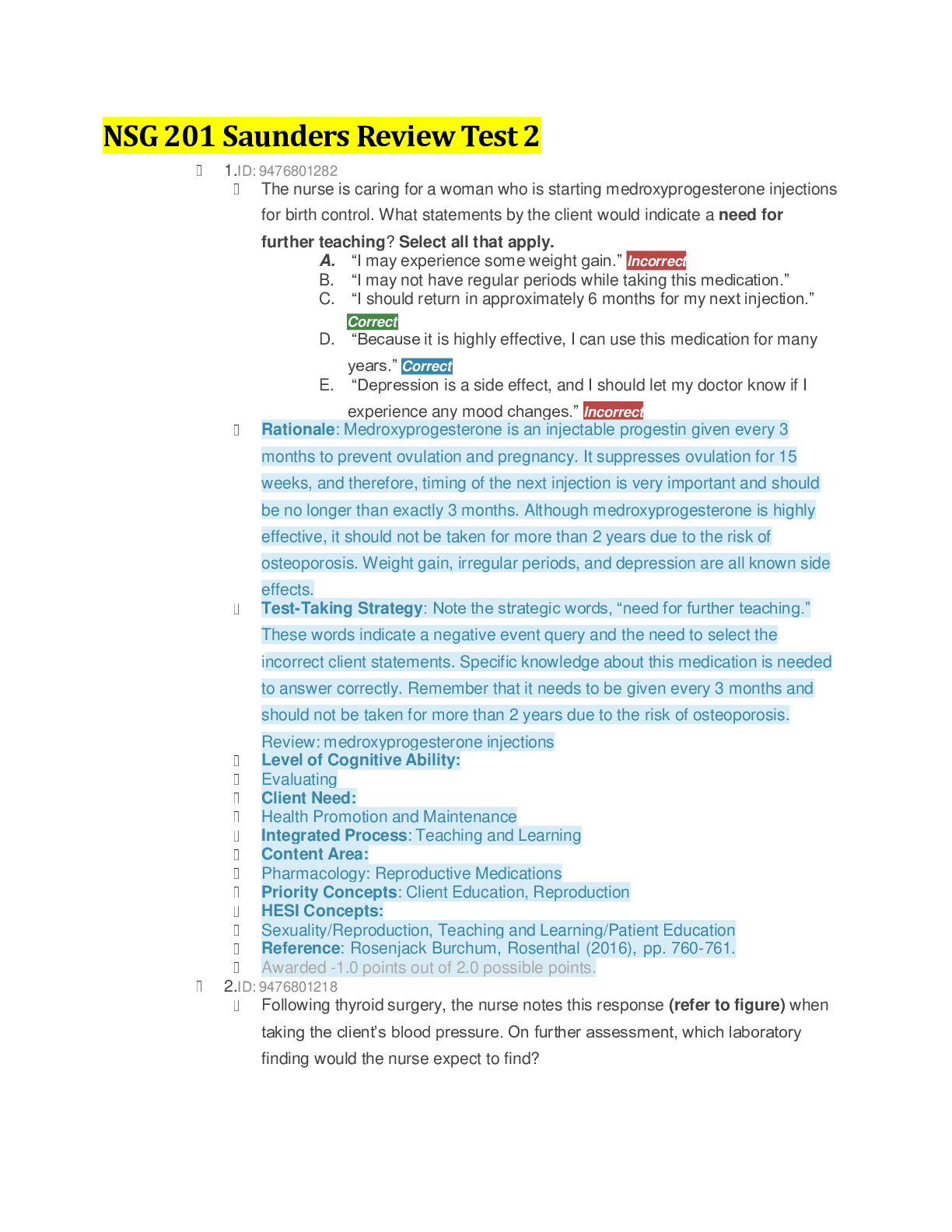

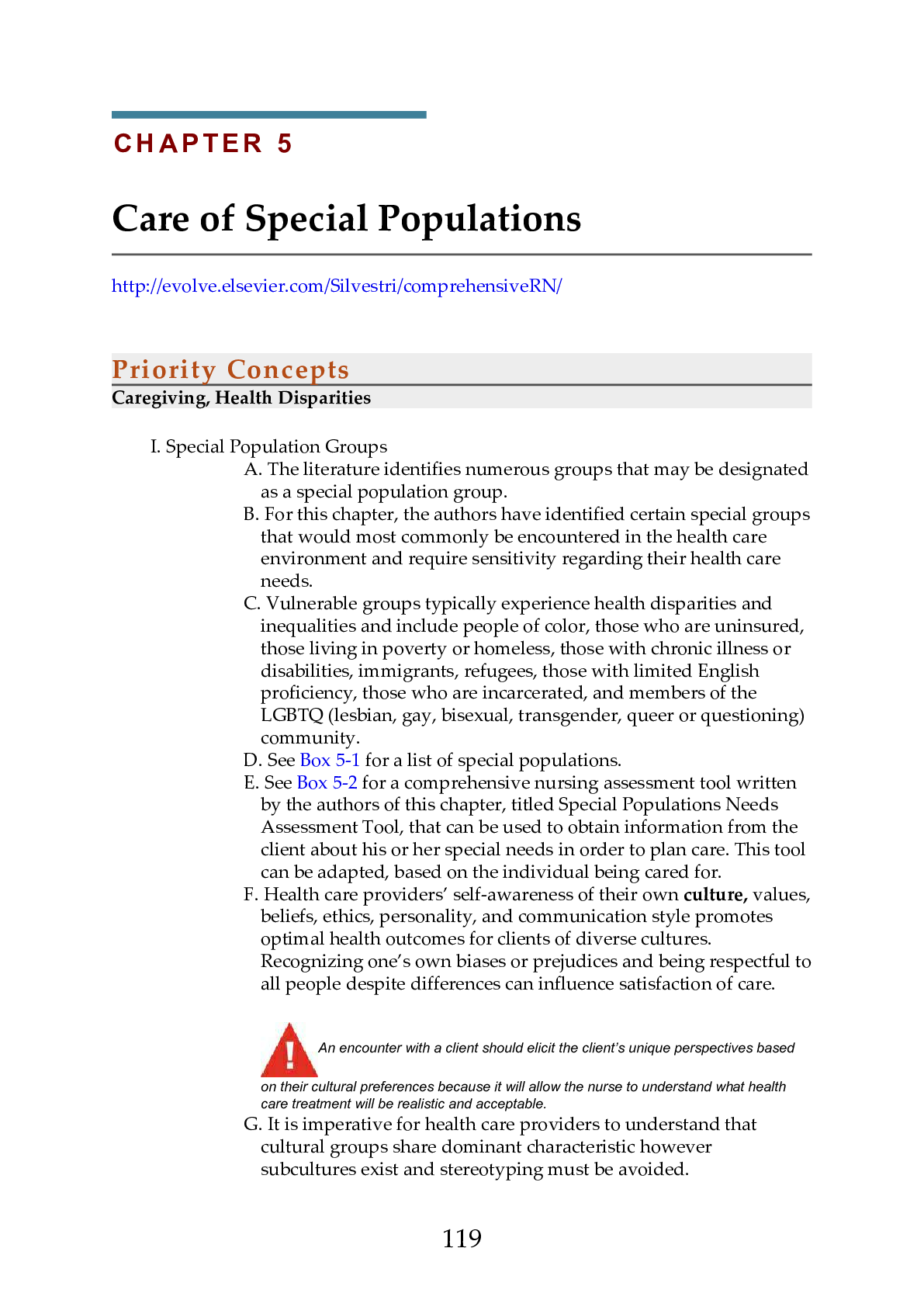

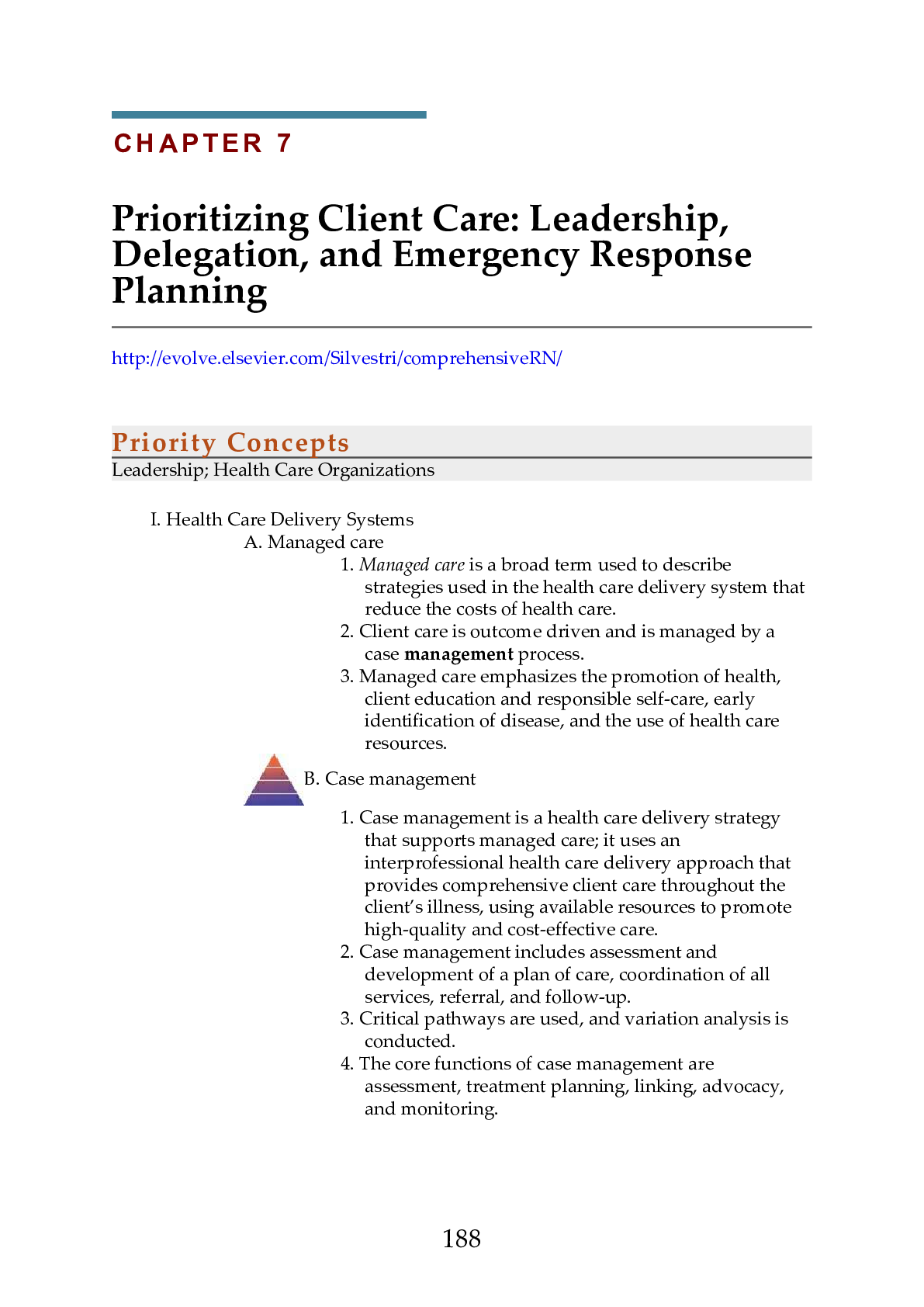
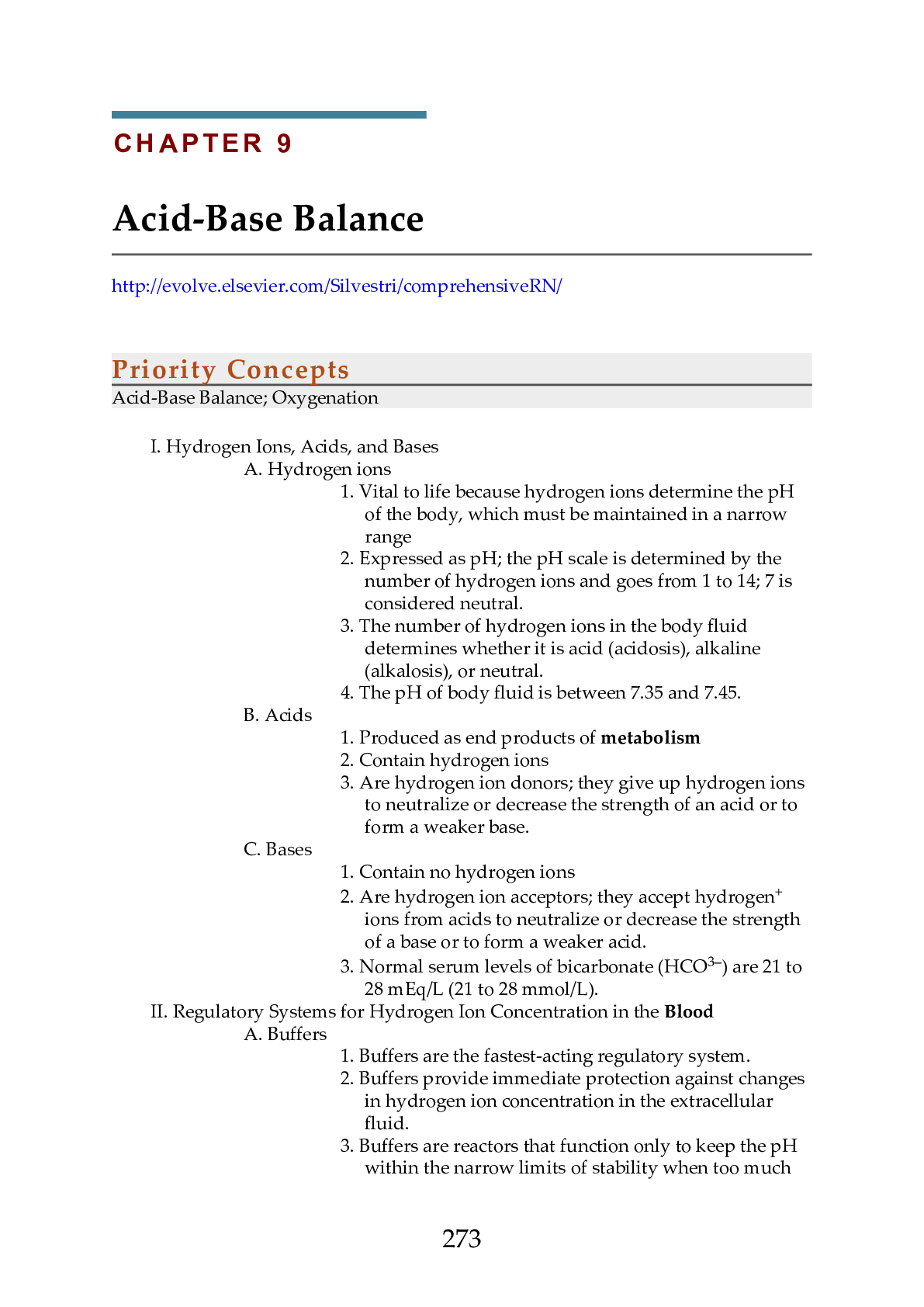



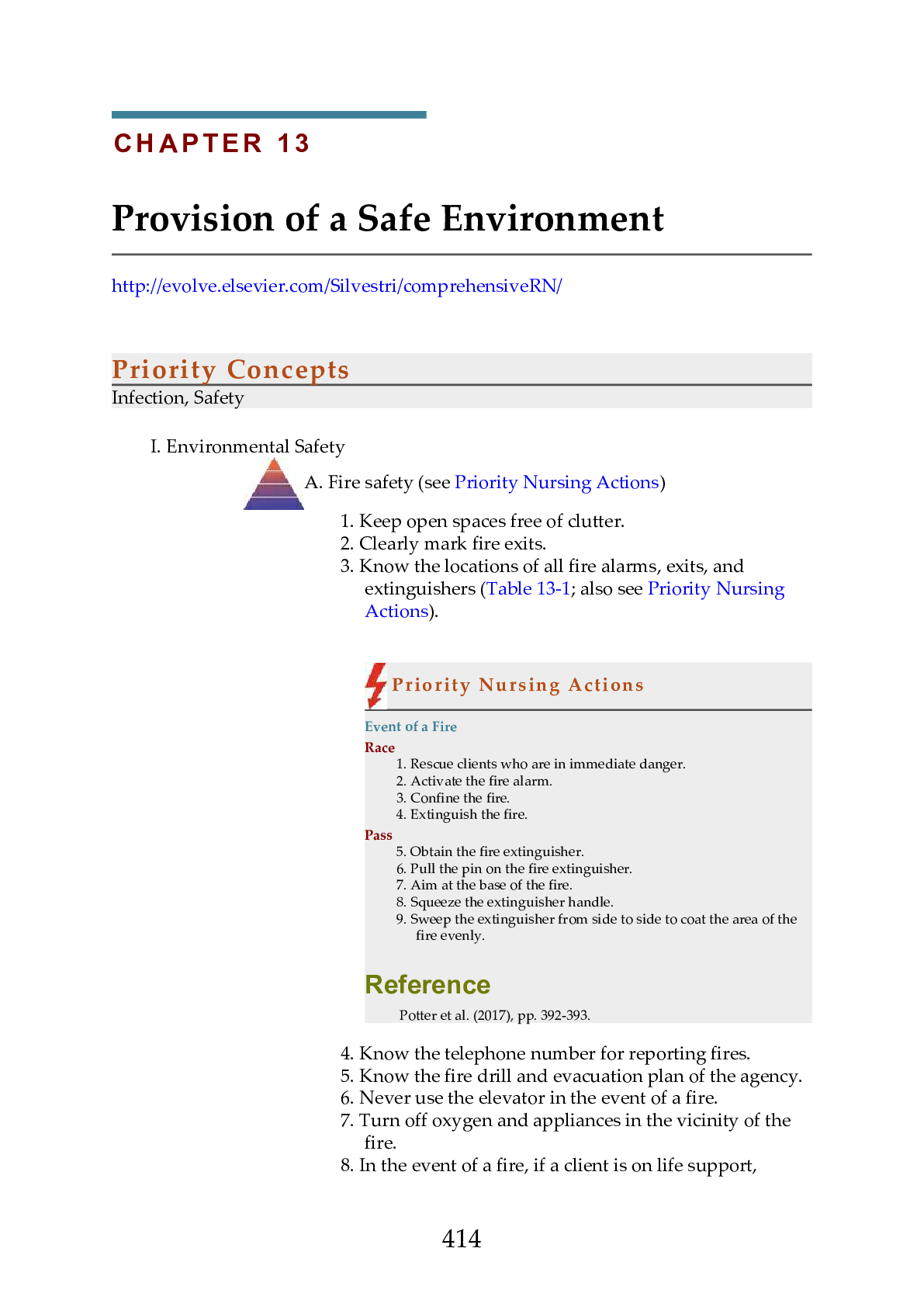


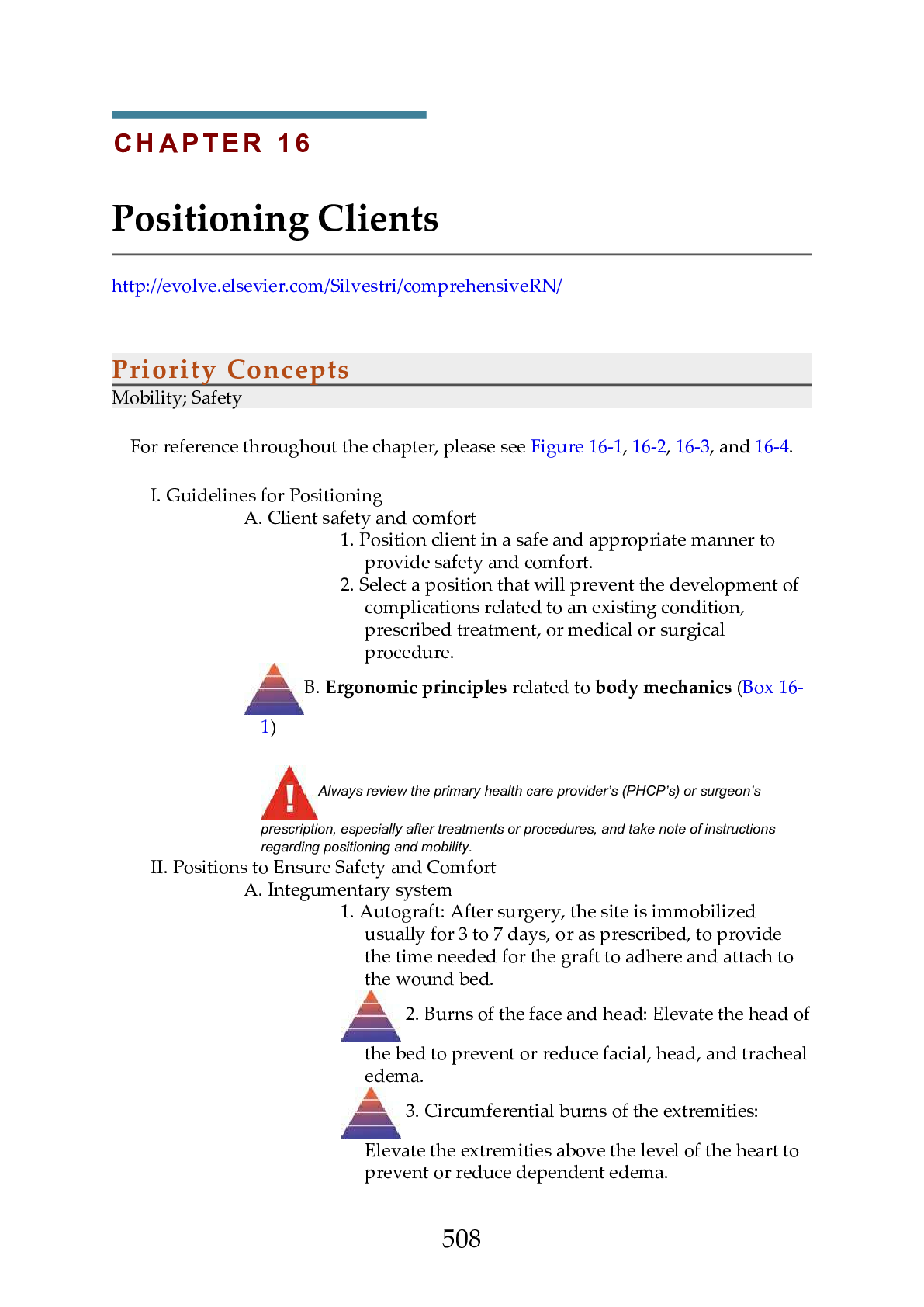


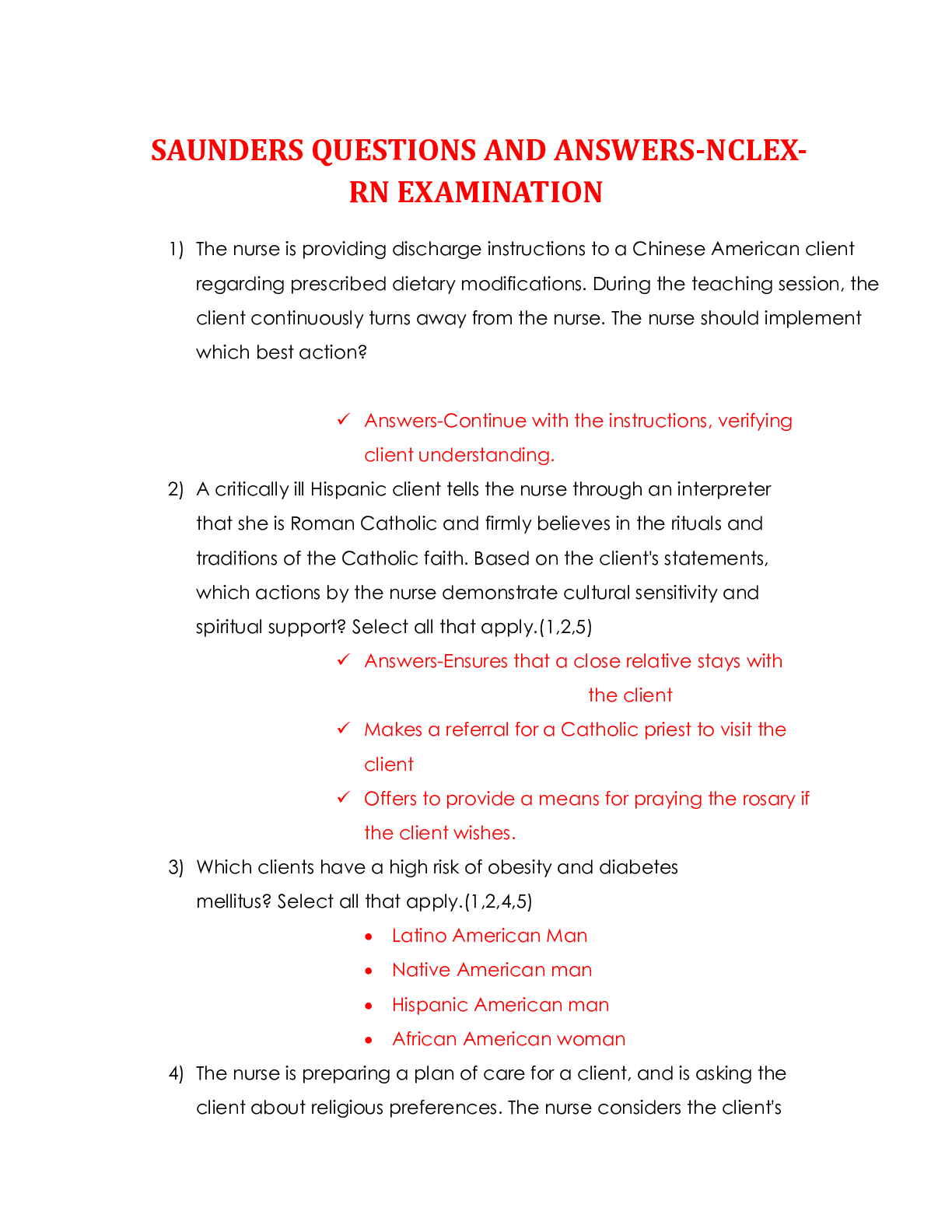

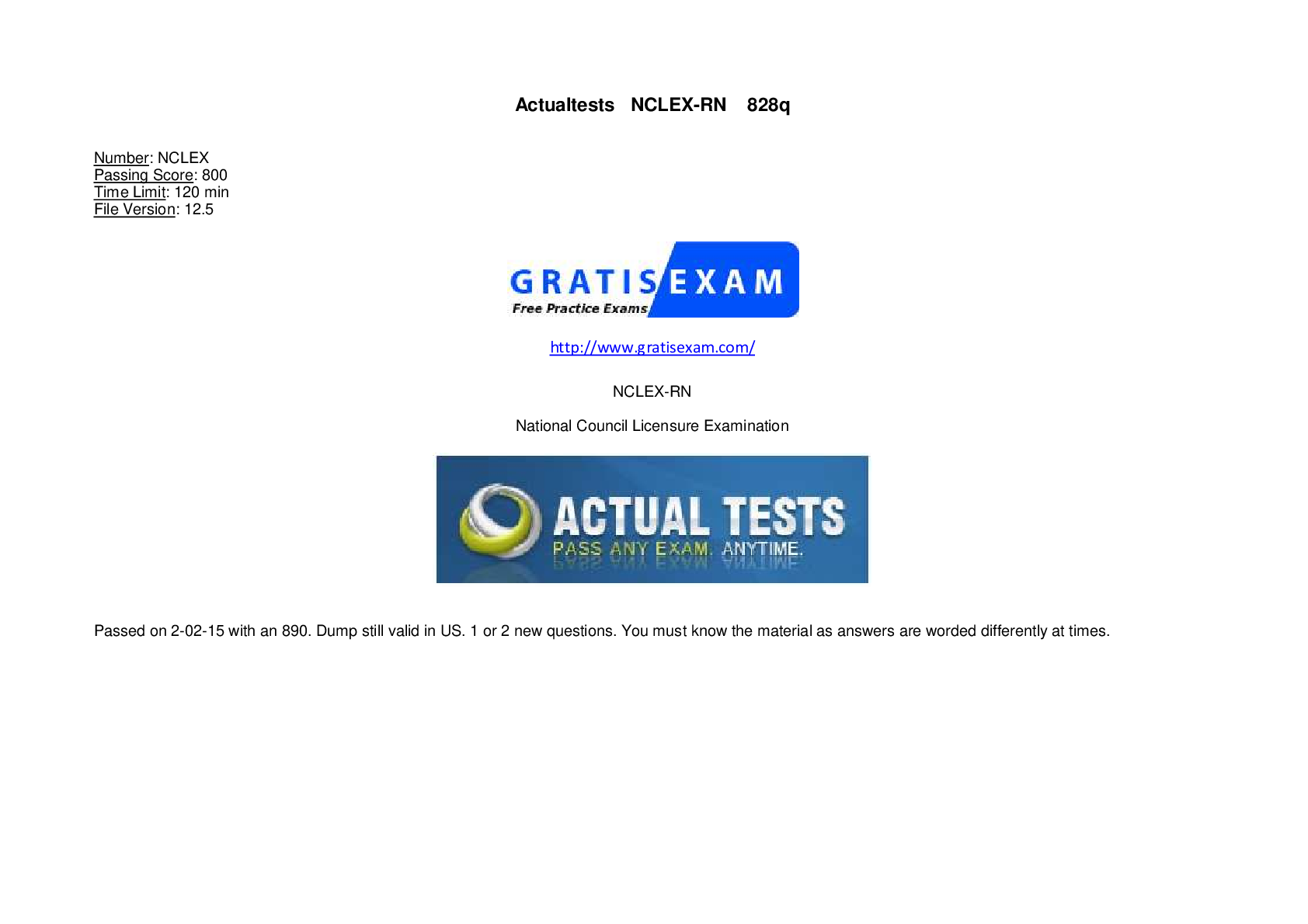
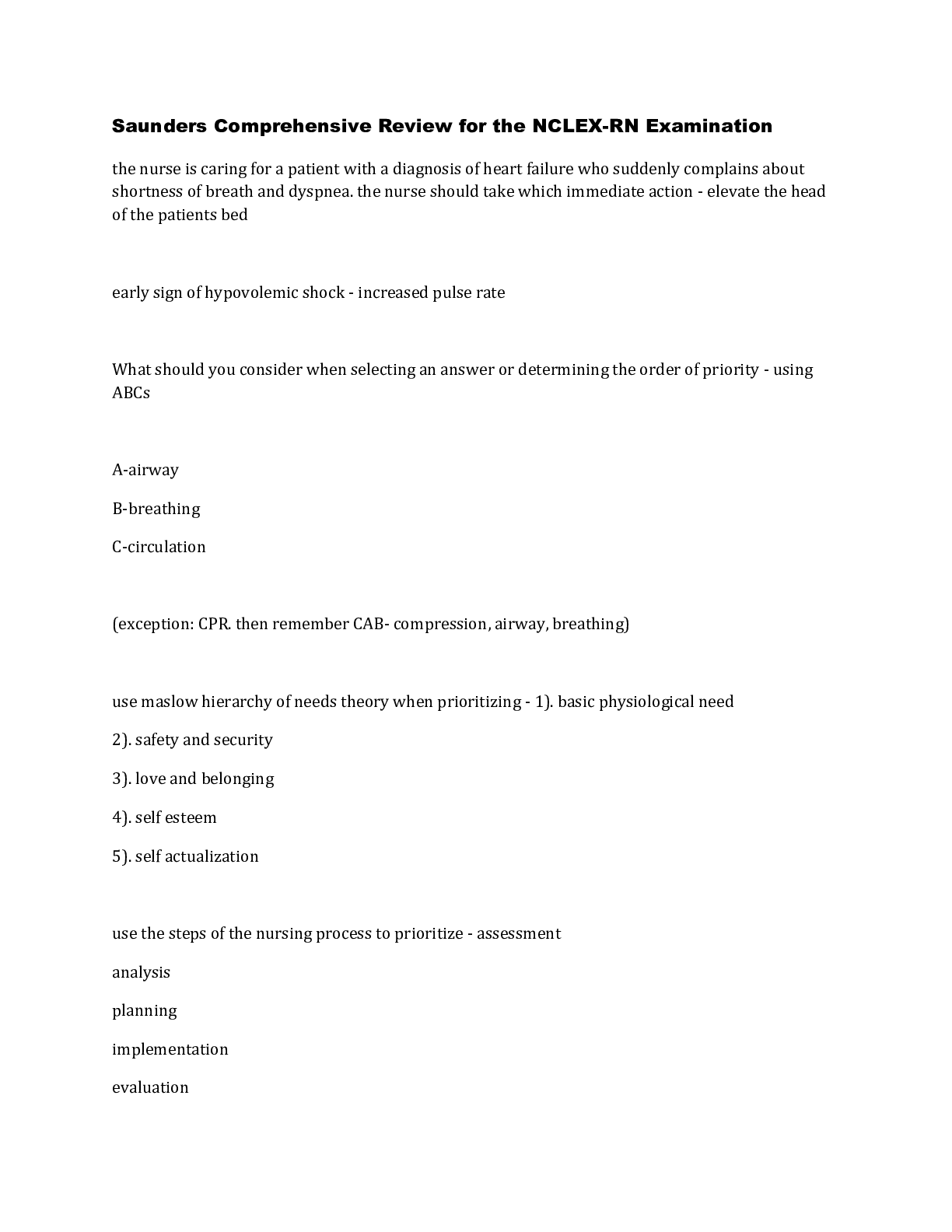





 With 850 Questions And Answers Guaranteed 100% Grade A.png)


